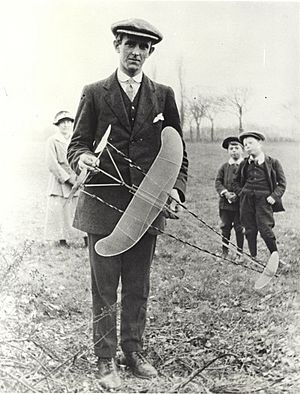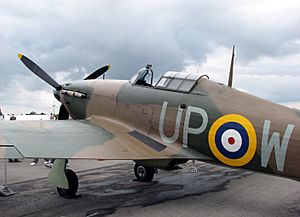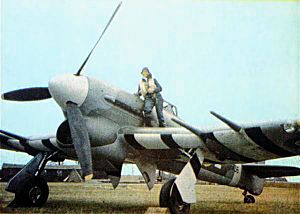Sydney Camm facts for kids
Quick facts for kids
Sydney Camm
|
|
|---|---|

Sydney Camm at Windsor Model Aeroplane Club, around 1915, with a "twin-pusher" model plane that could fly freely.
|
|
| Born | 5 August 1893 Windsor, Berkshire, England
|
| Died | 12 March 1966 (aged 72) Richmond, London, England
|
| Resting place | Long Ditton Cemetery, Long Ditton, Surrey, England |
| Nationality | British |
| Education | Royal Free School, Windsor |
| Spouse(s) | Hilda Rose Starnes |
| Children | 1 daughter |
| Parent(s) | Frederick Camm, Mary Smith |
| Engineering career | |
| Discipline | Aeronautics |
| Institutions | RAeS |
| Employer(s) | Hawker Siddeley |
| Significant design | Hawker Hurricane, Hawker Hunter |
| Significant advance | Hawker Siddeley P.1127 |
| Awards | Knight Bachelor (1953) British Gold Medal for Aeronautics (1949) RAeS Gold Medal (1958) Daniel Guggenheim Medal (1965) International Hall of Aerospace Fame (1984) |
Sir Sydney Camm (born August 5, 1893 – died March 12, 1966) was a brilliant English engineer. He designed many famous aircraft for the Hawker company. His designs ranged from early biplanes in the 1920s to powerful jet fighters. One of his most well-known planes was the Hawker Hurricane, which played a huge role in World War II.
Contents
Early Life and Model Planes
Sydney Camm was born in Windsor, England. He was the oldest of twelve children. His father was a carpenter. Sydney went to the Royal Free School in Windsor. He left school at 15 to become an apprentice carpenter.
From a young age, Sydney loved aeronautics, which is the science of flying. He and his brothers built model airplanes. They even sold them to students at Eton College! These activities led him to help start the Windsor Model Aeroplane Club in 1912. That same year, he and others at the club built a glider big enough for a person to fly in.
Starting an Aviation Career
Just before World War I began, Sydney Camm got a job at the Martinsyde aircraft company. He started as a carpenter. But his talent quickly moved him to the drawing office. This is where he designed aircraft.
In 1923, Camm joined the Hawker Aircraft Company. He became a senior draughtsman, which is like a lead designer. His very first design for Hawker was the Hawker Cygnet. It was so successful that he became the chief designer in 1925.
Sydney Camm was responsible for creating 52 different types of aircraft at Hawker. An amazing 26,000 of these planes were built in total! In the 1930s, most of the planes used by the Royal Air Force (RAF) were designed by him.
Designing World War II Aircraft
Camm went on to design some of the most important planes of World War II. These included the Hawker Hurricane, Hawker Typhoon, and Hawker Tempest.
The Hawker Hurricane

With the Hurricane, Sydney Camm helped aircraft design move forward. Planes changed from older biplanes (with two sets of wings) to faster, more modern monoplanes (with one set of wings). The Hurricane was a powerful fighter plane. It could fly faster and higher than many planes before it.
A full-size replica of the Hawker Hurricane stands near the River Thames in Windsor. It honors Sir Sydney Camm's amazing aircraft.
The Hawker Typhoon
When the Typhoon first flew, pilots noticed some issues at high speeds. Sydney Camm and his small design team worked hard to fix these problems. They made the Typhoon a very effective combat plane.
The Typhoon was often used as a fighter-bomber. It was great at flying low and carrying weapons. It could also take a lot of damage. This plane was very important in battles like the Battle of the Falaise Pocket. Ground-attack aircraft like the Typhoon caused huge losses for the enemy.
The Hawker Tempest
The Hawker Tempest was designed using lessons learned from the Typhoon. The Air Ministry asked for a new design soon after the Typhoon entered service. Camm decided to keep most of the Typhoon's design. He made changes to the wings and considered new, powerful engines.
Camm decided to use two different engines for the Tempest. The Tempest Mk 5 used the Napier Sabre engine. The Tempest Mk 2 used the Bristol Centaurus engine. The design was clever because it was easy to switch between the two engine types.
The Hawker Sea Fury
The Sea Fury was an improved version of the Tempest. It had smaller wings and a powerful Centaurus engine. It also gave the pilot a much better view. This plane, called the Hawker Sea Fury, was used by the Royal Navy from 1947 to 1955.
After World War II
After World War II, Sydney Camm designed many jet-powered aircraft. These planes became very important during the Cold War.
The Hawker P.1127 / Harrier
One of Camm's most notable post-war designs was the Hawker Siddeley P.1127. This plane was the start of the famous Hawker Siddeley Harrier. The Harrier is known for its ability to take off and land vertically, like a helicopter! This is called vertical takeoff and landing (VTOL).
Designing the Harrier needed many new technologies. These included special engines that could change the direction of their thrust. Sydney Camm played a major role in developing these important systems. In 1953, he was knighted for his achievements in aviation. The P.1127 first flew on October 21, 1960.
The Hawker Hunter
Before the Harrier, Camm also worked on the Hawker Hunter. This jet fighter is considered his most important aircraft design after World War II. The Hunter made its first flight in 1951.
Later Years and Legacy
Sydney Camm was made a knight on June 2, 1953, during the coronation of Queen Elizabeth II. This meant he was called "Sir Sydney Camm."
He was also the President of the Royal Aeronautical Society from 1954 to 1955. This society holds a special lecture every two years in his honor.
Camm retired as chief designer at Hawker in 1965. However, he remained on the board of Hawker Siddeley until his death. Before he passed away, he was even planning a design for an aircraft that could fly at Mach 4 (four times the speed of sound)! This shows how much aviation had changed in his lifetime. He started by building a glider in 1912, just nine years after the first powered flight.
In 1966, Camm received the Guggenheim Gold Medal, a very high honor. It was given to him after he passed away.
Death
Sir Sydney Camm died on March 12, 1966, at the age of 72. He was playing golf at the Richmond Golf Club when he passed away. He was buried in Long Ditton Cemetery in Surrey.
Tributes
A road in Kingston-upon-Thames called 'Camm Gardens' was named after him. There is also a memorial there, featuring a World War II propeller engine hub.
In 2012, a full-size replica of a Hawker Hurricane was put up near his childhood home in Windsor. This was another tribute to his amazing work.
In 1984, Sydney Camm was added to the International Air & Space Hall of Fame. This is a special place at the San Diego Air & Space Museum that honors aviation pioneers.
A bronze statue of Sydney Camm was placed in Kingston Library in 2014.
Images for kids
See also
- Hawker Siddeley







